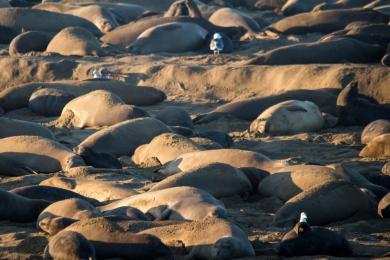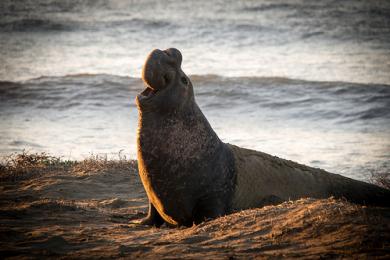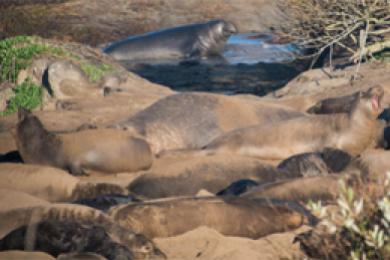Almost immediately we started seeing elephant seals, even though we were at least 500 yards from the beach. I couldn't help but think that this was quite a strenuous hike for the seals; their bodies, after all, are much better suited for water than for land. But our guide, Ranger Tiffany Bailie, explained that the seals that were inland were just looking for a little peace and quiet away from the rest of the herd.
When we arrived at the beach, seals were everywhere - sleeping - completely oblivious to our arrival. The sun was just below the horizon, but there was enough light, so we set up and began taking pictures. The seagulls milling about, seemingly waking up the seals, looked like attendants in livery doing their jobs. As we photographed, we watched the alpha males begin their daily work of protecting their harems.
The ranger explained that the female seals group together in harems under the protection of the alpha male. He will keep the lesser (beta) males out, and holds the privilege of mating with the females when they are ready. The beta males crowd around the outside of the harems, waiting for an opportunity to sneak in or catch the female on her way out to sea.
The female elephant seals come ashore in winter to give birth to their pups and stay on shore until their pups are weaned. In the process they lose up 40% of their body weight as they don't eat for up to a month while suckling the pups. After a while, according to Ranger Bailie, the mother seals get so hungry that they abandon their babies and return to the sea to feed. The weaned pups are left to fend for themselves and eventually get so hungry that they too go into the water and teach themselves how to swim and hunt.
Well, all good things must come to an end and, after almost 4 hours of photographing, our expedition ended and we returned to civilization. As a final note, it is good to know that, as a result of the elephant seals being protected, their numbers have gone from near extinction to over 150,000.
The Sunrise Photography Tour was very informative, and I will definitely do it again.
Laura Oliphant
Photographers, both professional and amateur, are always anxious to have extended time to photograph the elephant seals at Año Nuevo under ideal conditions--something that’s hard to do on the usual guided tours. This year (2013), California state parks and CSPA met this need by offering Sunrise Photography Tours, giving small groups of photographers extraordinary access to photograph the seals in the early morning light.
Update: The Sunrise Photography tours continue to be offered every year in January and February. Tickets can be purchased in October and they do sell out quickly. If you want to be sure to be notified when the tickets are available, please sign up for our emails.



